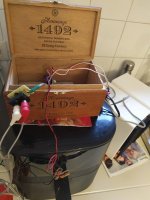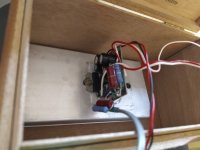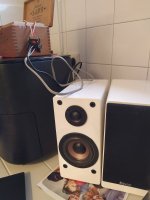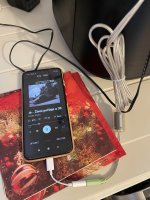But shouldn't my quad 909 with 22 amps of current output be enough to drive most speakers well, okay this is not the same thing as current drive i do acknowledge that@goodguys
i made a real newbie thread on this with the big patience of the pros here for which I am grateful
I wonder if someone tried to make from a chip amplifier a current amplifier design (inspired by Esa Merilainens - current drive info Website) if that is technically possible.
Maybe it is easier to do that with a chip amp or it is not possible at all. At hand I have some amplifier with TDA7266 soon - which has two times seven watts.
Would like to hear some feedback on this, maybe a modification of an existing mini-amplifier from the far east which could be found easily on ebay.
It would be enough for me to have two times five watts, just in order to hear such an amplifier together with...
- Freedom666
- Replies: 279
- Forum: Chip Amps
Nelson used the "simple resistor method" using 22 or 50ohms in line with the speaker to get current drive effect although losing efficiency you can make a listening test the easiest way like this.
series resistance method explained here
https://www.current-drive.info/9
using complex crossovers gives to midrange and tweeters often unknowingly a little bit current drive(!)
Nelson said in his document that tube amps are current drive so why not just use one of those rather than having to design your own amplifier, or modify an existing one@goodguys
i made a real newbie thread on this with the big patience of the pros here for which I am grateful
I wonder if someone tried to make from a chip amplifier a current amplifier design (inspired by Esa Merilainens - current drive info Website) if that is technically possible.
Maybe it is easier to do that with a chip amp or it is not possible at all. At hand I have some amplifier with TDA7266 soon - which has two times seven watts.
Would like to hear some feedback on this, maybe a modification of an existing mini-amplifier from the far east which could be found easily on ebay.
It would be enough for me to have two times five watts, just in order to hear such an amplifier together with...
- Freedom666
- Replies: 279
- Forum: Chip Amps
Nelson used the "simple resistor method" using 22 or 50ohms in line with the speaker to get current drive effect although losing efficiency you can make a listening test the easiest way like this.
series resistance method explained here
https://www.current-drive.info/9
using complex crossovers gives to midrange and tweeters often unknowingly a little bit current drive(!)
@goodguys
In my experience, most fullrange speakers sound better with transconductance amps, but this is not a brick rule. You can use a voltage amp (i.e a normal one that you have) and use either passive, or active correction (see at Pass forum, FR EQ) to correct the response of a "misbehaving" fullrange driver. So don't get fixated to it.
Markaudio drivers are more neutral and are generally voiced to sound good with voltage amps.
By the way, it would be nice if you could post some pictures of your speakers experiments. You know, here we like to see pictures, even ugly ones (or it didn't happen! )
)
In my experience, most fullrange speakers sound better with transconductance amps, but this is not a brick rule. You can use a voltage amp (i.e a normal one that you have) and use either passive, or active correction (see at Pass forum, FR EQ) to correct the response of a "misbehaving" fullrange driver. So don't get fixated to it.
Markaudio drivers are more neutral and are generally voiced to sound good with voltage amps.
By the way, it would be nice if you could post some pictures of your speakers experiments. You know, here we like to see pictures, even ugly ones (or it didn't happen!
 )
)To give you an example of the simplest transconductnce amp: A modified tda 2005 chip.
Is it hi-fi? No.
Is it underpowered? Yes
Is it ugly? It depends.
Is it fun? Oh Yes!
So now playing in the kitchen, (while I bake pancakes) connected to a pair of small basically fullrange speakers.
So, not to get far offtopic:
Keep your Visatons, put them in a selaed boxes, as biggest you can find/build. Anything between 50-100 liters will work. (The bigger the better)
Build/buy a transconductance amp. Use it as your secondary system.
Enjoy! 🙂
Is it hi-fi? No.
Is it underpowered? Yes
Is it ugly? It depends.
Is it fun? Oh Yes!
So now playing in the kitchen, (while I bake pancakes) connected to a pair of small basically fullrange speakers.
So, not to get far offtopic:
Keep your Visatons, put them in a selaed boxes, as biggest you can find/build. Anything between 50-100 liters will work. (The bigger the better)
Build/buy a transconductance amp. Use it as your secondary system.
Enjoy! 🙂
Attachments
tube amps are current drive
That is not true — at least in most cases.
Tube amps are often have high impedance (Rout) but rarely greater than the loudspeaker’s impedance. This means they fall on the voltage amp side of zero. But they are often — especially SE amps — close enuff to 0 that the loudspeaker impedance starts to impose itself on the end frequency response of the system.
The Pass ACA also falls into this camp. This disgram might help — note this predates more accurate Rout numbers (they aren’t quite soclose to zero).
dave
In my experience, most fullrange speakers sound better with transconductance amps, but this is not a brick rule. You can use a voltage amp (i.e a normal one that you have) and use either passive, or active correction (see at Pass forum, FR EQ) to correct the response of a "misbehaving" fullrange driver. So don't get fixated to it.
Sorry i find it awfully difficult not to get fixated when audio is concerned - bad habit. This transconductance thing has been swimming around in my head all day.
If current drive amps are so good why are they not seen on a google search, no one seems to be making them
If i were to mimic nelson pass and place a 30 ohm resistor onto the output of my quad 909 would it sound better ?
So you don't mean the standard tda 2005 chip amp that is commonly available, what are the modsTo give you an example of the simplest transconductnce amp: A modified tda 2005 chip.
in the thread I posted you find this
Try this:

if you want to hardwire to the chip
"Current drive" is not same-as "current feedback". (I could debate if 2 Ohms is really "CFB" here but why?)claimed to be current drive without modification,
Great sound is due to current feedback topology
Try this:
if you want to hardwire to the chip
Found this nice schematic which is more orthodox for planing the hard wiring of the electronic parts. However my star grounding would be pin 3 on the TDA2003 IC as this is the shortest way to the chip.
With current drive amps you cannot use a crossover, with voltage drive you can use crossovers
It's difficult for one full range drive unit to reproduce the entire bandwidth of sounds the human ear can hear, so does that mean
in real life voltage drive amps are the better choice
And if current drive amps are better why cannot you buy them anywhere
It's difficult for one full range drive unit to reproduce the entire bandwidth of sounds the human ear can hear, so does that mean
in real life voltage drive amps are the better choice
And if current drive amps are better why cannot you buy them anywhere
I'll try to answer this: In my experience, transconductance amps tend to sound better (than voltage amps) with certain fullrange speakers (not all of them though).
If you connect a typical two/three way speaker with a crossover and bass reflex tuning designed for a voltage amp, to a current amp, it WILL sound bad. So, as this an industry, a marketplace, it's easier to stick to one standard that works most of the time, i.e. voltage amps, and design loudspekers with that premise.
There are articles on the net which discuss these issues better than I could explain.
So, essentially, motivated by the work done by Nelson Pass, I built transconductance amp mostly to enable me a better sound from a fullrange loudspeaker that does not behave as well.
So, somewhat more bass (due to higher impedance in the bass region), less midrange scream, and better highs.
So, a transconcuctance amp is a specific amp tailored to a specific loudspeaker. It is not a universal solution, quite the contrary.
The simplest mod you can try: find a high power 47ohm resistor (or connect several ones in series or parallell to obtain that vaule) and connect it it series between the + of your amp and the Visaton. It will give you some idea of the change in sound, and also you may want to apply a zobel-like circuit in parallel to the Visaton terminals. Try a 10 to 22 uF biporal capacitor in series with a 10 ohm resistor values... (Read Nelson Pass article several times 😉
P.S.
Don't you have any pictures of your loudspeakers?
If you connect a typical two/three way speaker with a crossover and bass reflex tuning designed for a voltage amp, to a current amp, it WILL sound bad. So, as this an industry, a marketplace, it's easier to stick to one standard that works most of the time, i.e. voltage amps, and design loudspekers with that premise.
There are articles on the net which discuss these issues better than I could explain.
So, essentially, motivated by the work done by Nelson Pass, I built transconductance amp mostly to enable me a better sound from a fullrange loudspeaker that does not behave as well.
So, somewhat more bass (due to higher impedance in the bass region), less midrange scream, and better highs.
So, a transconcuctance amp is a specific amp tailored to a specific loudspeaker. It is not a universal solution, quite the contrary.
The simplest mod you can try: find a high power 47ohm resistor (or connect several ones in series or parallell to obtain that vaule) and connect it it series between the + of your amp and the Visaton. It will give you some idea of the change in sound, and also you may want to apply a zobel-like circuit in parallel to the Visaton terminals. Try a 10 to 22 uF biporal capacitor in series with a 10 ohm resistor values... (Read Nelson Pass article several times 😉
P.S.
Don't you have any pictures of your loudspeakers?
no one seems to be making them
Because people like to mix & match speaker. With a current amp you have to be very choosy with your loudspeakers. Since most speaker makers assume a voltage amp they all to often do not pay much attention.
ake this impedance curve (Klipsch Reference Premiere RP-600M):
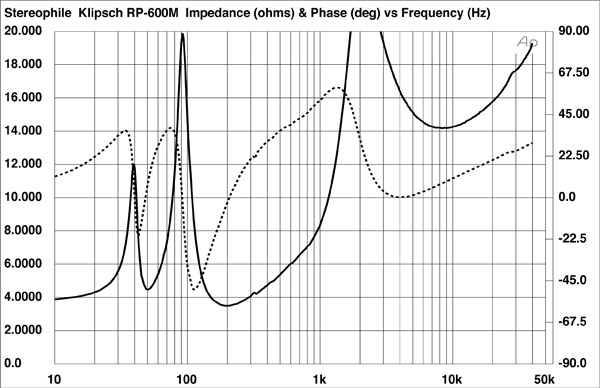
With a current amp you have changes in the frequency response caused bt the interaction of the Zspeaker with the Rout, with this loudspeaker an “elebvated” HF.
It either needs a voltage amp or significant EQ.
dave
Last edited:
With current drive amps you cannot use a crossover, with voltage drive you can use crossovers
If the XO is designed with flat impedance response it will work fine with a current amplifier..
Or use in an active system.
Or use a loudspeaker that expects a current-ish amp to compenate forthe otherwise droopy LF & HF (ie the larger FExx6 series drivers)
I had the opportunity to live with an amplifier with varibale output impedance (a simlier version advised Joe’s current amplifier). Every loudspeaker we tried sounded best with a different setting of the Rout.
for one full range drive unit to reproduce the entire bandwidth
As with many multi-way. 9 ½ octaves is achievable. But there will be limits on ultimate levels and HF ringing can be an issue. But on the whole, particularily with a more limited budget (say $1000 all in) one good FR can ”outperform" 2 or 3 drivers and an XO. Quality over quantity. And A decent FR build brings a “cohesiveness all to often missing when an XO is introduced.
With more budget, a WAW can eliminate many of the issues with a FR driver. Most OBs by necessity are WAWs (althou the top W is often an MT).
dave
Last edited:
Never forget the "tweeter killer" nature of the transconductance amps. If the crossover/tweeter pairing does a very high impedance peak on a particular frequency, the transconductance amp WILL send full swing on it. It does the same on the low end in a bass reflex box, but there is less damage due the higher power capability of the driver.
So current feedback is not for a layman, needs knowledge that you (hopefully) find on this forum, but rare on the consumer market.
So current feedback is not for a layman, needs knowledge that you (hopefully) find on this forum, but rare on the consumer market.
impedance in the highs and the mids can be easily linearized.
an overal parallel 20 ohms to a given 8 ohm loudspeaker will do a maybe sufficient linearization of impedance.
then a transconductance amplifier can be tried.
If you have EQ (maybe a smartfone EQ will do) you can use any given speaker with a CFA (curent feedback amplifier) just correcting the frequency response.
you can measure with spectroid app and pink noise from youtube
an overal parallel 20 ohms to a given 8 ohm loudspeaker will do a maybe sufficient linearization of impedance.
then a transconductance amplifier can be tried.
If you have EQ (maybe a smartfone EQ will do) you can use any given speaker with a CFA (curent feedback amplifier) just correcting the frequency response.
you can measure with spectroid app and pink noise from youtube
Sorry, going back to an earlier point, did you find much difference between the lowest priced markaudio drivers and the top of the range moap. If so can you talk about these differencesIf the XO is designed with flat impedance response it will work fine with a current amplifier..
Or use in an active system.
Or use a loudspeaker that expects a current-ish amp to compenate forthe otherwise droopy LF & HF (ie the larger FExx6 series drivers)
I had the opportunity to live with an amplifier with varibale output impedance (a simlier version advised Joe’s current amplifier). Every loudspeaker we tried sounded best with a different setting of the Rout.
As with many multi-way. 9 ½ octaves is achievable. But there will be limits on ultimate levels and HF ringing can be an issue. But on the whole, particularily with a more limited budget (say $1000 all in) one good FR can ”outperform" 2 or 3 drivers and an XO. Quality over quantity. And A decent FR build brings a “cohesiveness all to often missing when an XO is introduced.
With more budget, a WAW can eliminate many of the issues with a FR driver. Most OBs by necessity are WAWs (althou the top W is often an MT).
dave
People on the other forums are loving the lowest priced drivers saying they sound " absolutly fantastic very detailed etc "
Some people on this forum are saying that not to take the price of a speaker as an indication of audio performance. Maybe there are some bargains to be had with the cheaper markaudio drivers
@goodguys
not knowing the markaudio drivers but as someone who likes the magic of the use of metals for loudspeaker cones (diy metal foil on paper cone drivers) it is obvious for me that already the cheaper drivers of a brand using metal cones in their drivers in the tradition of Jordan Watts bring all the magic of good impulse response / transients this material has to offer:
Jordan: "the cone makes the music"
More expensive drivers usually have better ventilation, bigger magnets, longer stroke and maybe also some refinement on the cone itself.
diy sandwich aluminzed Fane Sovereign 15 300tc


not knowing the markaudio drivers but as someone who likes the magic of the use of metals for loudspeaker cones (diy metal foil on paper cone drivers) it is obvious for me that already the cheaper drivers of a brand using metal cones in their drivers in the tradition of Jordan Watts bring all the magic of good impulse response / transients this material has to offer:
Jordan: "the cone makes the music"
More expensive drivers usually have better ventilation, bigger magnets, longer stroke and maybe also some refinement on the cone itself.
diy sandwich aluminzed Fane Sovereign 15 300tc
@Freedom666
Thanks for tge pictures. Very nice. I'll have to try this mod on some of my old/spare fullrange speakers. 😉
But I am wondering why the @goodguys is hesitant to post pictures. This is a practical DIY forum, and I get bored by theoretical threads when we endlessly chew something without seeing any practical work...
Thanks for tge pictures. Very nice. I'll have to try this mod on some of my old/spare fullrange speakers. 😉
But I am wondering why the @goodguys is hesitant to post pictures. This is a practical DIY forum, and I get bored by theoretical threads when we endlessly chew something without seeing any practical work...
- Home
- Loudspeakers
- Full Range
- Visaton B200 upgrade
